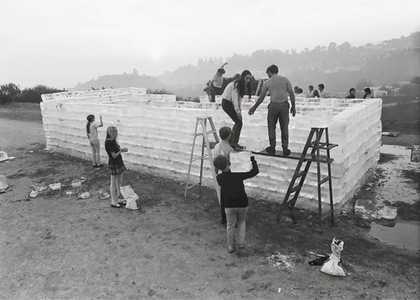Editors’ note
We’ve all played this game. Draw an image on a sheet of paper, fold the paper to conceal part of it, and then pass to the next person who adds their own drawing, and so on, after which the result is unravelled. This fun way of creating a little monster, or a weird hybrid body on paper is an example of the perfect collaborative act. The Surrealists took it up as their own, though André Breton was more serious about the Exquisite Corpse, declaring that it provided ‘the most fabulous source of unfindable images’. Here in Tate Etc. you’ll find one such example in Anne Ellegood’s exploration of different approaches to artistic collaboration – we publish for the first time Tate’s recently acquired Exquisite Corpse drawn by André Breton, Nusch Eluard, Valentine Hugo and Paul Eluard in 1930.
While the Surrealists went in for metaphorical displacement, Theo van Doesburg’s extensive and fruitful collaborations with artists, architects and designers, including Kurt Schwitters, László Moholy-Nagy, Piet Mondrian and El Lissitzky, created a truly international exchange of ideas of the early twentieth-century avant-garde, all of which will be explored in Tate Modern’s exhibition.
The pleasure of collaboration isn’t necessarily about the end result. In her essay on artists and failure, Lisa Le Feuvre quotes Fischli and Weiss, who when describing their film The Way Things Go 1987 noted: ‘For us, while we were making the piece, it was funnier when we failed…when it worked, that was more about satisfaction.’
For some, a collaborative effort has been about challenging the status quo. As part of Tate archive’s 40th anniversary celebrations, artist and former teacher David Page recounts the student solidarity during the Hornsey College of Art uprising in 1968 – a six-week sit-in that led to intense debate, extended confrontation with the local authorities, questions in Parliament and, rather successfully, a government report.
For others, collaboration can be defined in a more benign, abstract way – and might involve only the artist and the prospective audience. Of course, articulating such an approach can too easily turn into semantics. The French writer André Gide had a much grander, philosophical notion when he wrote: ‘Art is a collaboration between God and the artist, and the less the artist does the better.’

Allan Kaprow's happening Fluids, photographed by Dennis Hopper in Beverly Hills, October 1963
Courtesy Tony Shafrezi Gallery, New York. Photo: Dennis Hopper
Bice Curiger and Simon Grant

